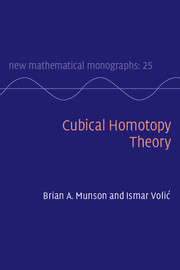Book contents
- Frontmatter
- Dedication
- Contents
- Preface
- PART I CUBICAL DIAGRAMS
- 1 Preliminaries
- 2 1-cubes: Homotopy fibers and cofibers
- 3 2-cubes: Homotopy pullbacks and pushouts
- 4 2-cubes: The Blakers–Massey Theorems
- 5 n-cubes: Generalized homotopy pullbacks and pushouts
- 6 The Blakers–Massey Theorems for n-cubes
- PART II GENERALIZATIONS, RELATED TOPICS, AND APPLICATIONS
- Appendix
- References
- Index
5 - n-cubes: Generalized homotopy pullbacks and pushouts
from PART I - CUBICAL DIAGRAMS
Published online by Cambridge University Press: 05 October 2015
- Frontmatter
- Dedication
- Contents
- Preface
- PART I CUBICAL DIAGRAMS
- 1 Preliminaries
- 2 1-cubes: Homotopy fibers and cofibers
- 3 2-cubes: Homotopy pullbacks and pushouts
- 4 2-cubes: The Blakers–Massey Theorems
- 5 n-cubes: Generalized homotopy pullbacks and pushouts
- 6 The Blakers–Massey Theorems for n-cubes
- PART II GENERALIZATIONS, RELATED TOPICS, AND APPLICATIONS
- Appendix
- References
- Index
Summary
In Chapter 3, we were interested in comparing the initial (final) space of a square to the homotopy limit (colimit) of the rest of the square. This led to the notion of a homotopy (co)cartesian and k-(co)cartesian squares and we established many interesting properties of such squares. This chapter is the cubical version of this story. In particular, we will define homotopy (co)cartesian cubes and their k-(co)cartesian counterparts and then discuss their various features. The narrative here will very closely parallel that of Sections 3.3, 3.4, 3.7, 3.8, and 3.9.
Cubical and punctured cubical diagrams
Here we set some notation and terminology. Let n ≥ 0 be an integer. Informally, a n-cube or n-cubical diagram of spaces is a commutative diagram in the shape of a n-cube. We have already studied 0-cubes (spaces), 1-cubes (maps of spaces), and 2-cubes (square diagrams), and even encountered the stray 3-cube. More formally, consider the poset P(n) of subsets of n = {1, . . ., n}. The poset structure is given by containment, so S ≤ T means S ⊂ T, and any poset may be considered as a category. In later chapters, we will refer to P(n) as a cubical indexing category. An n-cube of spaces X is a functor X: P(n) → Top (or to Top∗ for a cube of based spaces). The language of categories is discussed in Chapter 7. In particular the reader can consult Definition 7.1.1 and Definition 7.1.15 for the formal definitions of category and functor. However, we can easily describe what this means without the need for the language of functors and categories. An n-cube X is:
As we already mentioned, a 0-cube is a space X∅, a 1-cube is a map of spaces X∅ → X1, and a 2-cube is a commutative diagram
As in Chapter 3, we have written X1 and X12 in place of X{1} and X{1,2} above, and we will continue to do so.
- Type
- Chapter
- Information
- Cubical Homotopy Theory , pp. 221 - 287Publisher: Cambridge University PressPrint publication year: 2015



